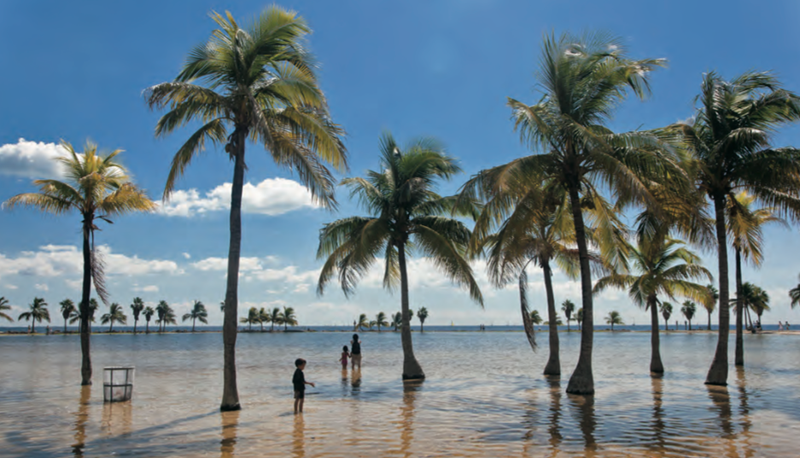The following time line after the table is of earth's average temperature since the last ice age, to see the time line in full size click here. The importance of this time line is two fold. First it clearly shows the past fluctations in climate temperature, against the fluctuations we are seeing today. Second it demonstrates that we have not only created and entered into a new "Epoch" but we are deep into this era call the Anthropocene period. This is a geological age create and governed by human activity, as the timeline demonstrates, scientist are now trying to pin point the date the Epoch began.
This Anthropocene Epoch speaks not just to the things we are experiencing such as air pollution or the warming climate, but to the more serious crisis of earth's systems changing to the point were it could become unihabitable for human beings and civilization as we know it.
Anthropocene Working Group Reports to IGC
The following summary was released just before Dr. Colin Waters of the British Goelogical Survey began the AWG's report to the International Geological Congress on Monday, August 29th, 2016.
Majority current opinion on the group indicates the following:
• The Anthropocene concept, as articulated by Paul Crutzen and Eugene Stoermer in 2000, is geologically real. The phenomenon is of sufficient scale to be considered as part of the International Chronostratigraphic Chart, more commonly known as the Geological Time Scale.
• Majority AWG opinion is for assignation as an Epoch/Series. This option is preferred over either a lower rank (e.g. Age/Stage, i.e. as a subdivision of the Holocene) or a higher rank such as a Period or Era. In such a step, and in common with all other geological time units, the Anthropocene would comprise both a 'pure time' unit (an Anthropocene Epoch) and an equivalent unit of strata (an Anthropocene Series).
• If the Anthropocene is adopted as an Epoch, this would mean that the Holocene has terminated, but that we remain within the Quaternary Period and Cenozoic Era.
• Human impact has left discernible traces on the stratigraphic record for thousands of years -- indeed, since before the beginning of the Holocene. However, substantial and approximately globally synchronous changes to the Earth System most clearly intensified in the 'Great Acceleration of the mid-20th century. The mid-20th century also coincides with the clearest and most distinctive array of signals imprinted upon recently deposited strata.
• Hence, the mid-20th century represents the optimal beginning of a potential Anthropocene Epoch (and, simultaneously, the base of the Anthropocene Series).
• Changes to the Earth System that characterize the potential Anthropocene Epoch include marked acceleration to rates of erosion and sedimentation, large-scale chemical perturbations to the cycles of carbon, nitrogen, phosphorus and other elements, the inception of significant change to global climate and sea level, and biotic changes such as unprecedented levels of species invasions across the Earth. Many of these changes are geologically long-lasting, and some are effectively irreversible.
• These and related processes have left an array of signals in recent strata, including plastic, aluminium and concrete particles, artificial radionuclides, changes to carbon and nitrogen isotope patterns, fly ash particles, and a variety of fossilizable biological remains. Many of these signals will leave a permanent record in the Earth's strata.
• The Anthropocene beginning might conceivably be defined by a Global Standard Stratigraphic Age (GSSA), i.e. a numerical age that can be expressed as a calendar date such as 1945. Or more, conventionally it could be defined by a Global boundary Stratotype Section and Point (GSSP), which is more colloquially a 'golden spike', and is a physical reference point in strata at one carefully selected place. Majority opinion on the AWG is to seek and choose a candidate GSSP, as this is the most familiar and widely accepted method of defining geological time units.
• The AWG has already begun the process of identification of potential GSSPs, by initial analysis of the general environments in which the best combinations of stratigraphic signals may be found (e.g. undisturbed lake or marine sediments, annually banded coral skeletons, polar snow/ice layers, speleothems and so on).
• This will lead to selection of sites for sampling and further analysis, to provide full descriptions of relevant signals in the strata, a process that we hope will lead to the identification of one or more suitable candidate sites for a GSSP. We would hope to complete this process over the next 2-3 years.
• This would then form the basis for the preparation of a formal proposal, to our immediate parent body, the Subcommission on Quaternary Stratigraphy (SQS), on defining a formal Anthropocene unit. If the SQS recommends this by supermajority vote, the proposal will go on to its parent body, the International Commission on Stratigraphy (ICS) to be voted on, with any vote in favour still needing to be ratified by the Executive Committee of the International Union of Geological Sciences (IUGS).
• If all of these conditions can be fulfilled, then the Anthropocene would become a formal part of the Geological Time Scale.
Results of AWG Vote (35 members):
• Is the Anthropocene stratigraphically real? For: 34, Against: 0, Abstain: 1
• Should the Anthropocene be formalised? For:30, Against: 3, Abstain: 2
• Hierarchical level of the Anthropocene? Era: 2, Period: 1.5, Epoch: 20.5, Sub-epoch: 1, Age: 2, Sub-age: 0, None: 1, Uncertain: 3, Abstain: 4
• Base/beginning of the Anthropocene ? ~7ka: 0, ~3ka: 1.3, 1610 Orbis: 0, ~1800: 0, ~1950: 28.3, ~1964: 1.3, Diachronous: 4, Uncertain: 0, Abstain: 0
• GSSA .v. GSSP? GSSP: 25.5, GSSA: 1.5, Uncertain: 8
• What is the Primary Signal? aluminium: 0, plastic: 3, fuel ash particles: 2, carbon dioxide concentration: 3, methane concentration: 0, carbon isotope change: 2, oxygen isotope change: 0, radiocarbon bomb spike: 4, Plutonium fallout: 10, Nitrate concentration / nitrogen isotope change: 0, Biostratigraphic: extinction/ assemblage change: 0, Other (lead, persistent organic pollutants, technofossils): 3, Uncertain: 2, Abstain: 6.





